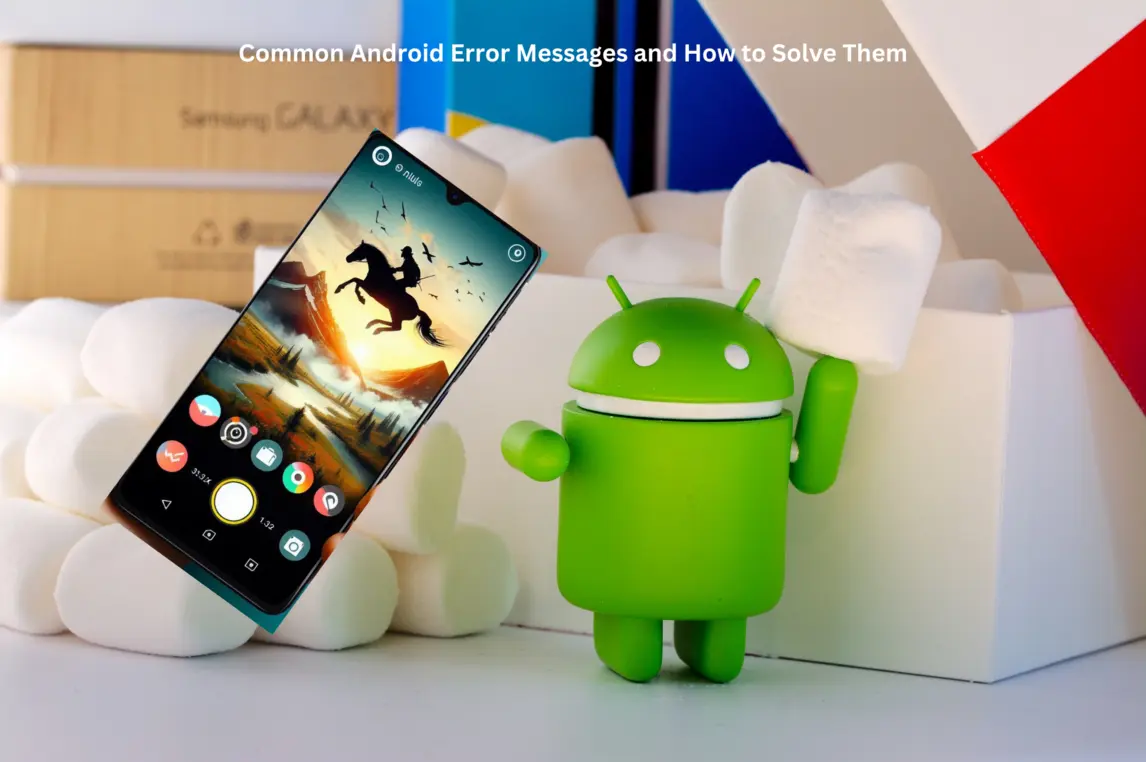Android smartphones have become an essential part of daily life, helping users stay connected, informed, and entertained. However, as with any technology, Android phones can encounter various errors that may disrupt your experience. In this blog post, we’ll go over common Android error messages and offer solutions to fix them. Whether you’re dealing with app crashes or storage issues, we’ve got you covered!
1. “Unfortunately, App Has Stopped” Error
One of the most common Android error messages is “Unfortunately, App Has Stopped”, which occurs when an app crashes unexpectedly. This can be due to a bug, low memory, or corrupted data.
How to fix it:
- Clear Cache and Data: Go to Settings > Apps > [App Name] > Storage > Clear Cache and Clear Data.
- Update the App: Open Google Play Store and check for app updates.
- Reinstall the App: Uninstall and reinstall the app to resolve any internal issues.
- Restart Your Phone: Sometimes, a simple restart can resolve the problem.
2. “Insufficient Storage Available” Error
This error pops up when your device runs out of storage space, making it difficult to install new apps or save files.
How to fix it:
- Free Up Storage Space: Delete unnecessary files, apps, photos, or videos.
- Move Data to an SD Card: If your phone supports SD cards, move files to free up internal storage.
- Use Cloud Storage: Backup files using Google Drive or other cloud storage services.
- Clear Cached Data: Go to Settings > Storage > Cached data and clear it to free up space.
3. “Google Play Store Has Stopped” Error
This error often occurs due to corrupted data in the Google Play Store app.
How to fix it:
- Clear Cache and Data: Navigate to Settings > Apps > Google Play Store > Storage > Clear Cache and Clear Data.
- Re-add Your Google Account: Go to Settings > Accounts > Google, remove your Google account, and add it again.
- Check for Play Store Updates: Update the Google Play Store to ensure smooth functionality.
4. “No SIM Card Detected” Error
This error appears when your Android phone cannot detect the SIM card, which can occur due to hardware issues or improper SIM placement.
How to fix it:
- Check SIM Card Placement: Ensure the SIM card is inserted correctly in the SIM slot.
- Restart Your Phone: A restart can sometimes resolve the issue.
- Try Another SIM Card: Test another SIM card to see if the issue is with the SIM or the phone.
- Clean the SIM Card: Gently clean the metal contacts on the SIM card and reinsert it.
5. Wi-Fi Authentication Error
This error appears when your device fails to connect to a Wi-Fi network due to incorrect credentials or network issues.
How to fix it:
- Re-enter the Wi-Fi Password: Ensure the password is correct and try again.
- Forget and Reconnect to the Network: Go to Settings > Wi-Fi > [Network Name] > Forget, then reconnect.
- Restart Router and Phone: Restarting both devices can resolve the issue.
- Reset Network Settings: Go to Settings > System > Reset options > Reset Wi-Fi, mobile, and Bluetooth.
6. “Screen Overlay Detected” Error
This error occurs when apps with screen overlay permissions (such as Facebook Messenger) interfere with other apps.
How to fix it:
- Disable Overlay: Go to Settings > Apps > Special Access > Draw over other apps and disable permissions for apps causing the issue.
- Close Overlay Apps: Temporarily disable or close apps using screen overlays.
7. “Process System Isn’t Responding” Error
This common Android error often occurs due to low memory, software conflicts, or system bugs.
How to fix it:
- Restart Your Phone: Restarting can often resolve system issues.
- Free Up Memory: Close background apps and clear cache to free up RAM.
- Update System Software: Check for any available system updates and install them.
- Perform a Factory Reset: If the problem persists, back up your data and perform a factory reset.
8. “Unable to Download App” Error
This error occurs when there is insufficient storage or connectivity issues preventing app downloads.
How to fix it:
- Clear Google Play Store Cache: Go to Settings > Apps > Google Play Store > Clear Cache.
- Free Up Storage: Delete files and apps to free up space for downloads.
- Check Internet Connection: Ensure you have a stable Wi-Fi or mobile data connection.
9. Battery Draining Too Fast
Fast battery drainage can occur due to background apps, outdated software, or power-hungry settings.
How to fix it:
- Check Battery Usage: Go to Settings > Battery and identify apps that are draining the most battery.
- Enable Battery Saver: Activate battery saver mode to extend battery life.
- Update Software: Ensure your phone is running the latest software version.
- Turn Off Unnecessary Features: Disable Bluetooth, GPS, and Wi-Fi when not in use.
10. “Application Not Installed” Error
This error occurs when an app fails to install due to permission issues or file compatibility.
How to fix it:
- Check Compatibility: Ensure the app is compatible with your Android version.
- Free Up Storage: Clear space to ensure there’s enough room for the installation.
- Enable Unknown Sources: If installing an APK file, go to Settings > Security > Install from unknown sources.
- Clear Play Store Cache: Go to Settings > Apps > Google Play Store > Clear Cache.
11. “System Update Failed” Error
A system update can fail due to storage issues, network problems, or software conflicts.
How to fix it:
- Free Up Space: Ensure enough storage is available for the update.
- Check Wi-Fi Connection: Make sure you have a strong Wi-Fi signal before downloading the update.
- Restart and Retry: Restart your device and try downloading the update again.
- Factory Reset: As a last resort, backup your data and perform a factory reset.
By following these troubleshooting steps, you can resolve most common Android error messages and ensure your device runs smoothly. Regular maintenance such as clearing cache, updating apps, and freeing up storage can prevent many of these issues from occurring in the first place.
If you found this guide helpful, share it with others to help them troubleshoot their Android devices effectively!

